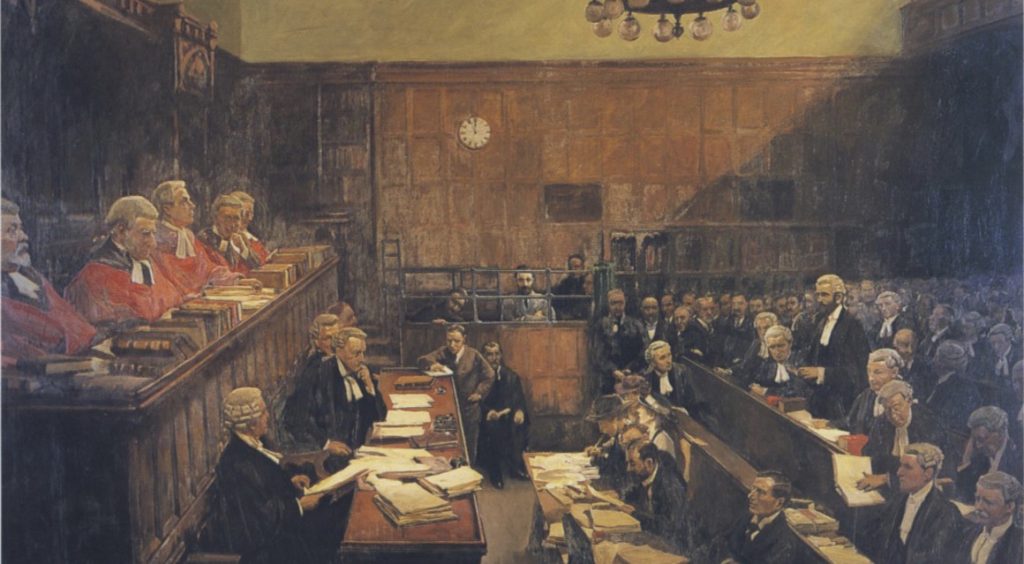While tensions on the island of Ireland were growing as internal disputes seemed to be reaching a climactic head, Sir Roger Casement (1864–1916) was busy in Germany, promoting Irish nationalism. Casement, a former advocate of imperialism, spent eighteen months in Germany in an attempt to secure support, arms and to induce captured Irish soldiers in the British Army to alter their allegiance and to fight as a part of his ‘Irish Brigade’. Despite initial positivity concerning recruitment, Casement grew dismayed with what he saw as inadequate commitment from his German allies. Casement believed that an Irish insurrection without adequate German support was doomed to failure and so he set out for Ireland in an attempt to stop the rebellion from taking place. After departing in a German submarine a logistical failure saw Casement swimming to shore at Banna strand in Co. Kerry. Landing exhausted and ill it was not long before Casement was captured and brought to London for interrogation. During this period of detention Casement repeatedly requested to communicate with the rebel leaders in order to persuade them to call off the insurrection but this was not permitted.
Following the outbreak and suppression of the Easter Rising, Roger Casement was brought to trial in the Old Bailey in June 1916. The former British diplomat was charged with ‘levying war against the king or being adherent to the king’s enemies in his realm, giving them aid and comfort in the realm or elsewhere’. Casement’s counsel, Alexander Martin Sullivan (1871–1959), attempted to argue, unsuccessfully, that any treason which had occurred had done so outside of the realm. After a trial lasting four days the jury returned their verdict in less than one hour and Sir Roger Casement was declared guilty. Stripped of his knighthood and convicted of treason the Irish nationalist was sentenced to death by hanging on 3 August 1916. The occasion of Casement’s trial and appeal was sensational enough to attract the attention of noted artist Sir John Lavery (1856-1941). This attention resulted in the creation of a unique social and legal record of a historic event.

The sentence of execution passed on Roger Casement came to be an extremely influential milestone in the narrative of the 1916 Rising. Correspondence with figures such as George Gavan Duffy (1882-1951) and Alice Stopford Green (1847-1929) reflect this as the support for their petition to reprieve Roger Casement grew over the summer months. Among the supporters for leniency were notable literary figures William Butler Yeats (1865-1939), Clement King Shorter (1857-1926) and George Bernard Shaw (1856-1950). That appeal only increased the sensationalism of Casement’s case as British officials retaliated with the publication of diaries reportedly written by Casement. The diaries contained details of homosexual encounters with young men and adolescents and their publication within the media was designed to undermine Casement’s petition for appeal. Additionally, the diaries’ content could hopefully have the added effect of preventing a cult of martyrdom being built around Casement as was already being constructed around the executed leaders of the Rising. Only one of these objectives succeeded. A source of contention, as many of Casement’s supporters claimed the diaries were forged, the infamous ‘black diaries’ have often side-tracked the narrative of Casement’s life and works for Irish nationalism. Aside from the notable figures who came to Casement’s aid his influence can be traced in the everyday correspondence of ordinary people, such as May Fay who prayed for Casement’s conversion to Catholicism before his execution.
Roger Casement was hanged on 3 August 1916, a day after he had been received into the Catholic church, and buried in Pentonville jail. Casement’s remains were returned to Ireland in February 1965 and after an elaborate state funeral, they were reburied in Glasnevin cemetery. The day before his execution Casement wrote his final letter to Margaret Gavan Duffy (1876-1967) and expressed his last sentiments in the Irish republican tradition of martyrdom, ‘Tomorrow St Stephen’s Day I die the death I sought and may God forgive the mistakes and receive the intent — Ireland’s freedom.’ One hundred years on from his execution and Sir Roger Casement is no less prevalent in Irish history. His continued significance is highlighted by his position as the focal point of the Hugh Lane Gallery’s 2016 commemorative exhibition. However, Casement’s narrative should not be limited to the sensationalism surrounding his final days. In addition to being a casualty of the 1916 Rising Sir Roger Casement was a complex figure who raises many more complex questions. From knighted British diplomat to Irish rebel, an Irish Protestant until his final moments, Roger Casement highlights the complexity of Irish nationalism.
By Hannah Healy
References:
Michael Laffan, ‘Casement, Sir Roger David’, in James McGuire and James Quinn (ed), Dictionary of Irish Biography. (Cambridge, 2010). (http://dib.cambridge.org/viewReadPage.do?articleId=a1532)
Paul Bew, ‘The Real Importance of Sir Roger Casement’, History Ireland, 2:2 (1994), pp. 42-45